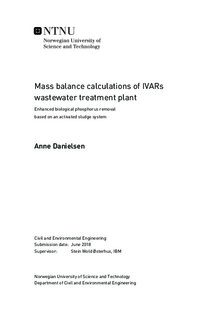| dc.description.abstract | This master thesis is written as a collaboration between NTNU and IVAR. IVAR's largest wastewater treatment plant has been the main focus, in Norwegian referred to as Sentralrenseanlegg Nord-Jæren (SNJ). The aim of this master was to make a theoretical mass balance of the existing biological treatment plant. IVAR SNJ recently changed from chemical precipitation to enhanced biological phosphorus removal in an activated sludge system. The reconstruction was fully implemented at IVAR SNJ in March 2018. A theoretical mass balance model could be a useful analyzing tool, that can emphasize possible limitations in the system to help reach a more optimized operation of the plant.
This thesis has been based on desktop work, where finding relevant literature to construct equations needed in the mass balance model have been a large part of the total workload. Each process has been examined, to find what is removed where, when and how. The existing system is complexed, because several of the process are dependent on the recycle of flows, hence it has also been very time consuming to make the excel-model functional. The last period have been used to test different scenarios in the model, with the purpose of imitating a normal operating situation at IVAR SNJ.
The wastewater entering IVAR SNJ is diluted, especially with low phosphorus and COD concentrations. Based on the results collected from the model phosphorus seems to be the main limitation for microbial growth at IVAR SNJ. The current biomass production at IVAR SNJ is assumed to be very low if existing, due to identical influent and effluent soluble phosphorus concentrations. From the model, approximately 70 % of total phosphorus entering the treatment plant is discharged into the sea, where the largest fraction follows the reject flow from the centrifugal dewatering process.
With the existing sludge treatment line phosphorus is not removed or utilized as a resource. To optimize the existing wastewater treatment plant the sludge treatment line need to change within a short period of time. The recommendation would be to implement an anaerobic mixer prior the anaerobic digestion (AD), to provoke release of luxury-P. By implementing this change the risk for unwanted struvite precipitation in the sludge treatment line would be drastically reduced, and phosphorus would be recovered and utilized as resource in IVARs fertilizer product, Minorga. | |

